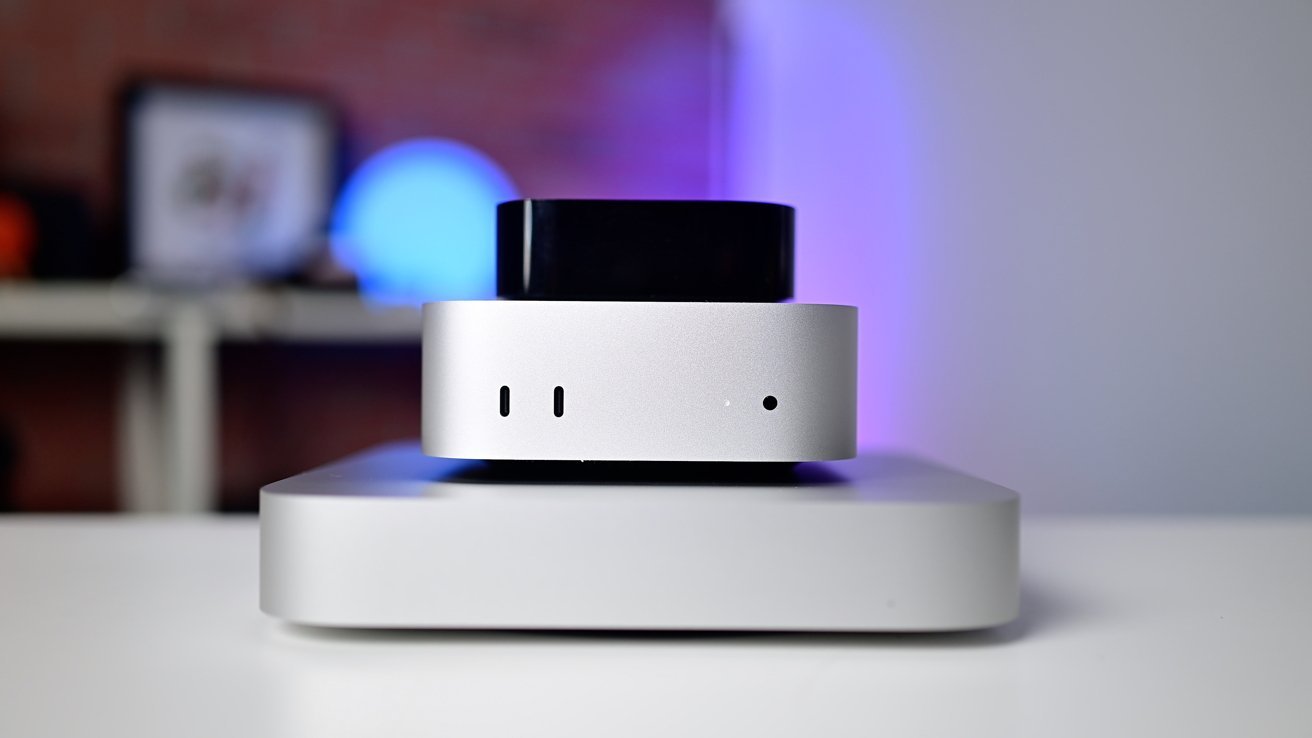
The M4 Mac mini [middle] between an older Mac mini [below] and an Apple TV [above]

The redesign of the M4 Mac mini could’ve been even smaller, Apple executives have admitted, but there were quite a few tradeoffs needed to produce the best version yet.
Apple’s revamp of the Mac mini with the M4 and M4 Pro chip led to a much more compact design with quite a few physical changes. Aside from size, it also saw a shift of ports to the front, as well as the under-mounted power button.
In talking about the redesign effort to Fast Company, Apple VP of hardware engineering Kate Bergeron and Mac marketing’s Sophie Le Guen explained that it was a balancing act.
“Mac Mini holds a special place in our hearts,” Bergeron said. “This product is an incredibly important part of the Mac lineup, and we didn’t want to do it a disservice by not spending the time we needed to make it great.”
Likening it to a three-legged stool that needed changes in multiple areas simultaneously to remain balanced, Bergeron offers that the needs of Apple Silicon were the first consideration. The team first asked what kind of Mac mini was needed that was optimized around Apple Silicon, while also balancing user performance and design expectations.
Not too small
Initially, designers brought “something that’s probably too small to get where we want,” Bergeron states, based on the expectations that the Mac mini would be both small and versatile. “But that’s their job – to challenge us in the physical space.”
The inclusion of an M4 Pro variant meant the design needed to include improved cooling, which also fed into acoustic considerations. “We probably could have been even more aggressive [with the smaller size of the Mac mini] if we decided to only design for M4,” Bergeron admits, adding that it was important to design for pro customers as well.
The vice president continued “We have to bundle all of those [considerations] together and do a lot of negotiating with the design team to figure out where we’ll land.”
Port placement
As part of the negotiation, there was also an opportunity to make a change to the port structure, departing from the usual rear-only port collection. Le Guen pointed to two key reasons for the change.
The first was the Mac Studio, deemed a design success while also being the first Mac desktop to use front-facing ports since the 2012 Mac Pro. The other was user feedback.
Some people would change the orientation of the device so that they could have easy access to each of the [rear USB] ports,” outlines Le Guen. “That led to [us saying], Let’s listen to the users and ensure that we are offering the convenience they’re looking for.'”
While users did ask for the ability to upgrade storage, the modular version in the New Mac mini is actually for a different reason. The modular storage was to help create “flexibility in manufacturing” according to Bergeron.
The tight constraints of the Mac mini’s internals mean “there’s not enough room on the main logic board to put the storage right on the board” for larger storage configurations, Bergeron explains.
As for the power button’s underside positioning, it was also a compromise in design. Bergeron defends the position as offering “pretty good access” to the button, and that since users often put their Mac to sleep, “it’s very rare to use the power button.”
“The versatility of having all of those [new front-facing USB] ports we though was really [more] important.”
Environmental innovation
The model is the first carbon-neutral Mac in Apple’s history, one which also relies on lots of recycled metals. In addition to using 100% recycled zinc and recycled copper in its internal components, as well as 80% recycled steel for the Apple logo for the first time, there was also a big change in the enclosure’s production.
The enclosure is made from extruded aluminum, just like earlier models, which are cut to length. This was previously cut by a manufacturing saw with a 3-millimeter thickness, which led to unusable shavings of about the same thickness.
To minimize these shavings, a new cutting system was created using a diamond-plated nylon wire, measuring fractions of a millimeter thick. The change allowed for more material to be retained instead of being wasted as shavings.
A long term change?
When turning to the future of the model, the pair aren’t willing to comment about the product roadmap, as usual. However, Bergeron is hopeful that the design will be around for quite some time, like the previous iteration.
“We wanted to make sure that we’re going to give customers value for many years to come. And we’ll see where the vision takes us next time.”




